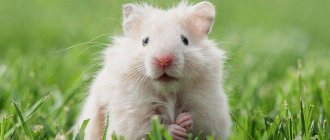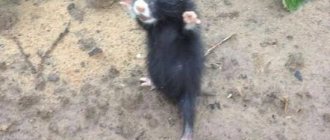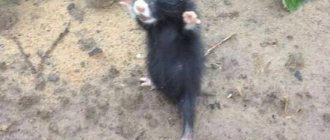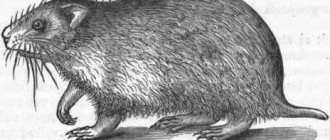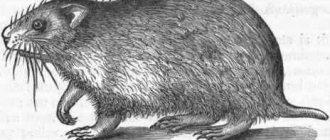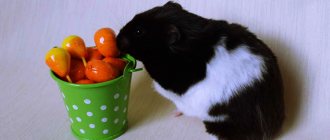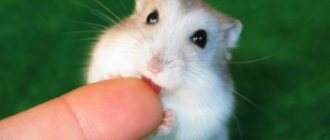Planet Earth is home to a huge number of hamsters and hamsters. They can be found on all continents, with the exception of Antarctica and Australia.
The largest number of varieties of these animals is found in America and on the islands off its coast (subfamily Sigmondontinae) (more information about the types of hamsters here). African hamsters belong to the subfamily Lophiomyinae, and those living in Eurasia belong to the subfamily Cricetinae, family Cricetidae.
The Central Asian (Syrian) hamster is well known as a pet. In the wild, it lives only in a small area in northwestern Syria.
The animals inhabit various biotypes: forests, forest-steppes, steppes, semi-deserts, deserts, savannas, mountains, shores of reservoirs. Many species settle in close proximity to humans.
On the territory of Russia, mainly in the steppe zone, 12 species of these animals are found.
Rat-like hamsters are common in China. Also found in Russia (Amur Region and Primorsky Territory).
What does a wild hamster look like?
The wild hamster has the following distinctive features:
- body length reaches 27-34 cm;
- average weight – 700 grams;
- muzzle of moderate length;
- the ears are relatively short, covered with thin dark hair;
- the tail is thick at the base, tapering towards the end, 3-8 cm long. Covered with short, stiff hair;
- the hand and foot are wide, the fingers have developed claws;
- limbs are short. Sometimes it seems that the hamster is crawling;
- The body hair is dense but soft.
The color of the animal is yellow or reddish-brown with black undercoat.
There is a black and white pattern on the body. The abdomen is black, on the sides there are light spots separated by black areas. There are light spots behind the ears, on the sides of the head (may be in the area of the shoulder blades). There are exclusively black specimens (melanists), some black with white spots on the paws and throat. The color becomes lighter in the direction from north to south within the range.
Did you know? According to the translation from the ancient Avestan language,
the word “hamster” means “an enemy who throws to the ground.” To pick up seeds, rodents bend plant stems to the ground.
Description of the rodent
— Advertising —
Hamsters are small rodents with a dense build, short legs, small ears and short tails. The body length ranges from 5 to 34 cm, the tail is from 0.7 to 10 cm in length. Females can exceed males in size. The fur is thick, the back is colored from ash or brownish-gray to dark brown-ochre. The abdomen is found in black, white or gray. There is a pronounced black stripe on the back. Hamsters also differ from other types of rodents in having well-developed cheek pouches.
Where do hamsters live in the wild?
The hamster prefers meadows, mixed-grass steppes and forest-steppes. The distribution area extends from Southern and Central Europe in the west to the Minusinsk steppe zone in the east, and in the south it descends to Northwestern China. There is an expansion of the range due to the destruction of forests.
The animal does not climb high into the mountains; the maximum height above sea level where it can be found is 1.5 kilometers. The hamster does not shy away from human proximity; it can make a home in the garden, vegetable garden, and sometimes in residential premises.
Interface used
Another type of classification is the interface used to connect the manipulator to the computer.
There are three types of mice:
PS/2.
They are connected via a round five-pin plug into the corresponding socket on the motherboard (usually marked green). The disadvantage is that after reconnecting the device, the computer does not respond to it, so a restart of the operating system is required.
USB.
A more advanced interface that allows you to change the mouse on the go or use several mice at the same time.
Wireless.
Through the air it communicates with a special transmitter connected via the USB port of the computer. Without this transmitter they do not work. The main disadvantages are the possibility of signal interception by attackers and batteries running out at the most inopportune moment.
In all other respects, the types of wireless mice do not differ from regular ones.
Lifestyle and character
The animal is endowed with decent size and reaches the dimensions of a large rat. Leads a solitary, more twilight lifestyle, likes to make new passages in its burrow, and stores food for the winter.
He loves dry, sandy soils of steppes and forest-steppe areas, where it does not cost him much effort to dig underground passages in a hole. It is also often found in meadow and agricultural areas, and can adapt to existence in mountain areas.
In the cold winter, it hides in a deep burrow underground (where there are storage rooms and bedrooms) and hibernates, but can wake up to eat. For convenience, the hamster lines the burrow chambers with grass, which it replaces as it becomes dirty.
Habitat
The habitat of a hamster depends on the species to which it belongs. Hamsters live almost throughout the entire territory of our country, in China and in European countries, with the exception of the northern countries (Finland, Norway, etc.).
Hamsters can be found in Syria and Iran and are able to survive even in desert climates. Their habitat is not limited to wild forests and deserted steppes - if you look closely, you can see traces of hamsters in city parks and squares.
What does a common hamster eat?
The animal has an excellent appetite and is not picky about food, but plant-based food prevails in its diet. In the spring and summer, the hamster loves to feast on insects and their larvae, and does not disdain small mice, reptiles, and amphibians (small vertebrates).
In autumn-winter, it switches to food from various types of seeds and tubers, the reserves of which are in sufficient quantities (from 0.5 to 16 kg) in its bins. In some cases, storerooms with supplies up to 90 kg were discovered.
Familiarize yourself with the features of keeping such popular breeds at home as the Siberian, Roborovsky, Royal, Angora, and Campbell hamsters.
The granaries are dominated by grains of wheat, rice, millet, buckwheat, lentils, lupine, as well as potatoes, carrots, peas, and corn. The animal feeds on them during temporary wakefulness from hibernation and early spring until young green shoots appear.
Special pouches behind the hamster’s cheeks are designed for short-term storage of food. He is able to carry about 50 grams of grains (other food) to his home at a distance of more than a kilometer, supporting the bags with his front paws, and with them he takes food out of them.
Often the cheeks hang down to the animal’s shoulders due to the overfilling of the sacs.
The hardworking, thrifty hamster also separates the grains by variety and puts each one separately.
The process of absorbing food occurs while sitting on its hind legs, and the hamster eats with its front legs: it stuffs food into one cheek, then the other, and quickly chews the contents.
Did you know? The common hamster is an excellent swimmer. The cheek pouches filled with air help him a lot when swimming.
Suitable home
Due to the fact that it is not recommended to walk the dzhungarika around the apartment, it needs a large and spacious cage. There should be enough space for walking and playing. There are several options for houses for dwarf rodents.
Cell
| Pros: | Minuses: |
|
|
Labyrinths
Houses with several compartments and passages between them resemble burrows. Mazes are usually more expensive than cages and aquariums, but they can be built gradually. Buy the main compartment first and then the top "room" and join them together.
Please note that for dwarf hamsters it is necessary that the compartments be connected by ladders. Toddlers can't climb up tunnels
If you decide to assemble such a house yourself from scrap materials, do not forget to make slits in the walls and ceiling. They will provide a constant flow of fresh air.
Aquarium house
Special plastic aquariums for rodents are great for dwarfs. Their small size allows them to make do with one-story dwellings. The main thing is that all the necessary accessories are there.
Where to put the cage?
Rodents feel good at the same air temperature as people. Do not place the cage in drafts or on a sunny windowsill. In addition, you should keep the cage away from:
- working battery;
- places with high humidity;
- TV;
- audio systems;
- other animals.
Do not place the house on the balcony (temperature changes, sun), in a draft (risk of colds), in the kitchen (not hygienic) and in the bedroom (rodents are active at night and make noise).
Cage equipment
What else will you need? The animal definitely needs:
- drinking bowl;
- Bowl;
- chalk stones or branches;
- nest (house);
- wheel;
- toys.
The ideal drinking bowl is the so-called dropper bottle. It needs to be hung away from the nest so that accidental drops do not wet it. Don't forget to change the water every day. Fresh water is the key to animal health.
It is better to place food in a heavy clay bowl so that the animal cannot turn it over. A hanging metal bowl will also work.
Chalk stones or branches are needed to point the teeth. Rodents' teeth grow throughout their lives, and if they are not taken care of, serious problems will begin.
In their natural habitat, rodents sleep in a separate compartment of their burrow. Try to create maximum comfort for him at home with the help of a small nest. Small wooden or plastic houses are suitable for this.
The wheel will help your pet get enough physical activity. Buy a solid wheel without slots or protrusions to protect the feet from fractures. Attach the wheel almost flush to the wall, otherwise the hamster may crawl between them and get stuck.
There are many toys for rodents at pet stores, but you can make many of them yourself. Excellent holes are made from cardboard toilet paper cylinders. Plastic rolling toys can successfully replace whole walnuts or hazelnuts. You shouldn’t fill the entire cage with toys – 1-2 is enough.
This is interesting: What running speed does a hyena develop?
Reproduction
The life expectancy of the described animal reaches four years in natural conditions, and six in captivity.
The breeding season begins in April and ends in October. The female is ready for mating at the age of 2.5–3 months. Since the embryos stay in the mother’s womb for only 16 days, during the specified period of time the female manages to bear 2-3 offspring.
The number of babies varies from 8 to 20, but more often it stops at 10. Males appear in females’ burrows only for mating, immediately leave their partner and do not take part in raising the offspring. Newborns weigh only 4–6 grams.
Babies develop extremely quickly. The lactation period lasts 3 weeks, but after a week the cubs are able to eat solid food (for example, grass). Two-week-old hamsters open their eyes and become covered with dense fur. The mother is responsible for the safety of the children.
In case of danger, the female carries the babies to a safe place in the cheek pouches.
It is not uncommon for first litter cubs to give birth to their babies by the end of summer.
Lifespan
Typically, a hamster's lifespan ranges from two to six years. Individuals that have undergone domestication conditions can live longer, however, wild living conditions affect their life expectancy. Having caught the eye of predatory animals and being left without sufficient food supplies, rodents do not live to see a year.
Adaptation to survival in nature still prevents animals from dying on their own. There are babies on the verge of extinction, listed in the International Red Book. These include the Syrian hamster and Newton's hamster. At the moment, their cultivation is carried out under human supervision and they are not released into the wild.
Representatives of hamsters are distinguished by their unique hearing and the ability to make unpleasant sounds. This becomes their weapon in the fight against emerging predators. They often use their sharp teeth. The main thing for animals is to protect their territory of residence.
Conservation status
Until 1960, the soft-haired animal was the object of the fur trade in Czechoslovakia, Germany and the USSR. A sharp decline in numbers forced the cessation of fur harvesting in the middle of the 20th century. Western European countries have approved national programs to ensure the conservation of this species.
These include Belgium, the Netherlands, Germany, Poland, France, Belarus and Ukraine. It is also protected in five constituent entities of the Russian Federation.
The number of animals is unchanged in Siberia and Kazakhstan, and the number of animals in the Krasnodar Territory and Azov District of the Rostov Region causes significant damage to agriculture. Although the total number of the species continues to decrease.
Did you know? Smart hamsters can remember their name and perform some tricks.
Enemies
Like any animal in the wild, the hamster has its enemies. Although the rodent is not large and it is not possible for it to repel large predators, despite this, predators cannot destroy hamsters as a species, they only keep the number of these animals at a not too large level. Among the predators that feed on hamsters are the following:
- terrestrial predators such as wolf, fox, lynx, which can wait and chase hamsters;
- birds of prey - in the daytime they hunt hamsters of the hawk family, but at night owls pose a danger to hamsters;
- pets such as cats and large breeds of dogs that may attack the hamster in suburban and urban areas.
For both wild and domestic hamsters, cats and dogs pose a serious danger. They can attack and eat a rodent, so the cage with the hamster must be kept out of the reach of the cat and dog.
Behavior
Hamsters are cautious and even cowardly. The behavior of rodents is subject to the instinct of self-preservation. These rodents are characterized by the habits of loners. They do not create groups within the population. All hamsters exhibit territorial behavior and defend their homes from their relatives. Hamsters never live in families.
Males form short-term communities near the female’s home during the courtship period. At this time, they demonstrate contented behavior, which is aimed at suppressing the partner’s aggressiveness and keeping her from running away.
The secret of special glands with which the male marks the territory makes the female more tolerant of courtship.
Peppermint treat
Ingredients:
- 1 medium overripe banana.
- 2 chicken eggs.
- 3 tbsp. spoons of honey.
- 3 tbsp. tablespoons of liquid coconut oil (can be replaced with sunflower oil in the same amount).
- 1/2 teaspoon mint flavoring.
- 1/2 teaspoon baking powder.
- A quarter cup of carob (roasted carob powder). A small amount of cocoa can be substituted, but this is not recommended for animals. Therefore, try to find an original product.
- Oat flour.
Cooking procedure.
1. Mash the banana in a bowl.
2. Beat eggs into the resulting mass, add honey, baking powder, cinnamon and coconut (sunflower) oil.
3. Add oatmeal to the mixture to form a firm but slightly moist dough.
4. Divide the resulting volume into 2 equal parts.
5. Pour 1/4 cup of carob powder into one half, and add the same amount of flour to the second half. A hard lump should form that does not stick to your hands.
6. Roll out 2 rectangles, 9-10 mm thick.
7. Place the layers of dough on top of each other and roll along the long side. Wrap the resulting sausage in plastic wrap and put it in the refrigerator overnight.
8. Preheat the oven to 180 degrees.
9. Cover a baking sheet with parchment paper.
10. Remove the film and cut into 3-3.5 cm rounds.
11. Place on a baking sheet. During cooking, portions of dough will not increase in volume, so you can place them close to each other.
12. Bake for 10-15 minutes.
If you want to please your pet with a crunchier treat, cut the rolls into thin slices (about 1 cm), and after cooking, additionally dry them in a warm oven or even in a non-stick frying pan.
The finished product is stored for a long time in a dry place. So, by baking peppermint rolls once, you can treat your four-legged pupil with them for a long time.
Bon appetit to your dog!
I like it I don't like it
